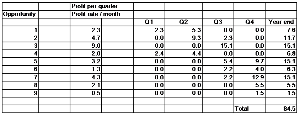Risk management - Business revenue and profit risk 2
Business revenue and profit risk part 2
Previously [see business schedule risk] and [see business revenue and profit risk] you have seen, for a list of opportunities, how to produce 3 point estimates for start, duration, revenue and profit margin. From this we have been able to calculate the total profit for an individual opportunity.
The above diagram now takes this one step further.
We need to calculate the profit for each quarter then sum these for the year end for each opportunity.
To do this we need to use the data seen previously [see business schedule risk] and [see business revenue and profit risk].
Profit rate / month
In order to calculate the profit for each quarter you need to know in what months the projects are active. Let us say that for a given project there is 2 months activity in Q1, then if you know the ‘profit rate’ per month we can calculate the profit for that period.
Firstly let us calculate the months of activity for Opportunity 4:
You know from the ‘business schedule risk table’ earlier that the START contribution was 1.8 months.
Note: When we refer to values as seen in the tables these are fixed at 1 or 2 decimal places. Risk management software will view these to many decimal places and calculate values much more accurately. Here we will keep to the simple view for ease of understanding.
This means that Opportunity 4 starts 1.8 months after 1st April, approximately the 3rd week in May. So, for Q1, Opportunity 4 only contributes PROFIT for 1.2 months (3 – 1.8). You also know that the total DURATION of opportunity 4 is 3.3 months (duration contribution). So, Q2 has 3.3 – 1.2 = 2.2 months (when calculated accurately by the spreadsheet).
In summary:
Q1 = 1.2 months Q2 = 2.2 months
Total = 3.3 months (when calculated accurately by the spreadsheet).
Now we need to multiply these values by the ‘profit rate per month’ to get the estimated profit for each quarter. Naturally, for opportunity 4 there is no activity in Q3 and Q4.
We calculate the ‘profit rate per month’ as follows:
Total profit (‘business revenue and profit table’) x WIN probability (‘business schedule risk table’)/ (end date – the likely start time) (‘business schedule risk table’) That is:
The total profit (once discounted for likelihood of gaining the contract)/months of activity.
16.06 x 0.4 / (5.2 -2) = 6.4/3.2 = 2.0
It is here that the probability of winning the contract is taken into account by using the weighting of 0.4.
Hence, the profit contributed by Opportunity 4 for Q1, Q2, Q3 and Q4 is:
Q1: 2.0 x 1.2 = 2.4 Q2: 2.0 x 2.2 = 4.4 Q3: 2.0 x 0.0 = 0 Q4: 2.0 x 0.0 = 0
The software will carry out these calculations for all of the opportunities to give total year end profits. These are added up to give the overall total profit for the year.
In this case = 84.5 (£84,500).
Note: We have assumed that the ‘profit rate’ is applied evenly over each month. This is the simplest system to use and where ‘costs’ are mostly labour there will be good agreement. Also, for simplicity, we have are calculating the profit via the revenue and using a suitable margin. We could just as easily have used 3 point estimates for REVENUE and COST to get cash flow.
The iteration for this model is discussed next [see business profit simulation].



